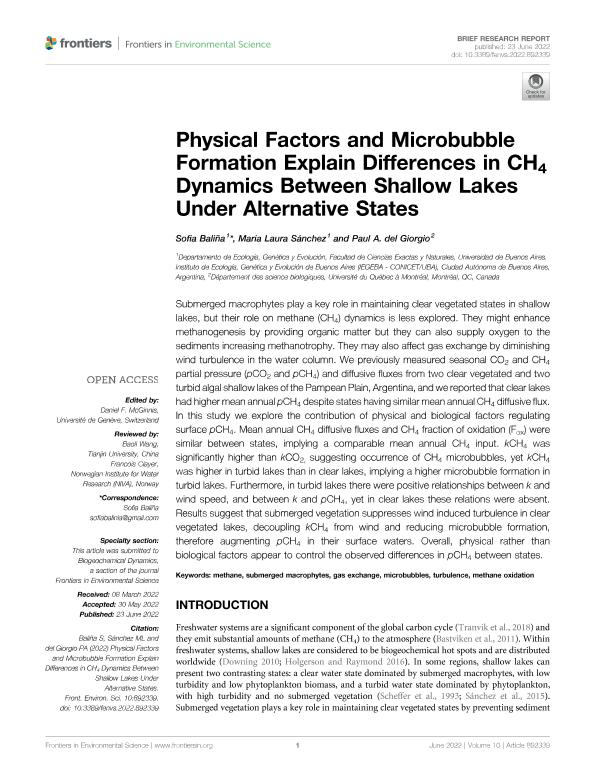Mostrar el registro sencillo del ítem
dc.contributor.author
Baliña, Sofía

dc.contributor.author
Sánchez, María Laura

dc.contributor.author
del Giorgio, Paul

dc.date.available
2023-09-28T17:50:24Z
dc.date.issued
2022-06
dc.identifier.citation
Baliña, Sofía; Sánchez, María Laura; del Giorgio, Paul; Physical Factors and Microbubble Formation Explain Differences in CH4 Dynamics Between Shallow Lakes Under Alternative States; Frontiers Media; Frontiers in Environmental Science; 10; 6-2022; 1-11
dc.identifier.issn
2296-665X
dc.identifier.uri
http://hdl.handle.net/11336/213469
dc.description.abstract
Submerged macrophytes play a key role in maintaining clear vegetated states in shallow lakes, but their role on methane (CH4) dynamics is less explored. They might enhance methanogenesis by providing organic matter but they can also supply oxygen to the sediments increasing methanotrophy. They may also affect gas exchange by diminishing wind turbulence in the water column. We previously measured seasonal CO2 and CH4 partial pressure (pCO2 and pCH4) and diffusive fluxes from two clear vegetated and two turbid algal shallow lakes of the Pampean Plain, Argentina, and we reported that clear lakes had higher mean annual pCH4 despite states having similar mean annual CH4 diffusive flux. In this study we explore the contribution of physical and biological factors regulating surface pCH4. Mean annual CH4 diffusive fluxes and CH4 fraction of oxidation (Fox) were similar between states, implying a comparable mean annual CH4 input. kCH4 was significantly higher than kCO2, suggesting occurrence of CH4 microbubbles, yet kCH4 was higher in turbid lakes than in clear lakes, implying a higher microbubble formation in turbid lakes. Furthermore, in turbid lakes there were positive relationships between k and wind speed, and between k and pCH4, yet in clear lakes these relations were absent. Results suggest that submerged vegetation suppresses wind induced turbulence in clear vegetated lakes, decoupling kCH4 from wind and reducing microbubble formation, therefore augmenting pCH4 in their surface waters. Overall, physical rather than biological factors appear to control the observed differences in pCH4 between states.
dc.format
application/pdf
dc.language.iso
eng
dc.publisher
Frontiers Media

dc.rights
info:eu-repo/semantics/openAccess
dc.rights.uri
https://creativecommons.org/licenses/by-nc-sa/2.5/ar/
dc.subject
GAS EXCHANGE
dc.subject
METHANE
dc.subject
METHANE OXIDATION
dc.subject
MICROBUBBLES
dc.subject
SUBMERGED MACROPHYTES
dc.subject
TURBULENCE
dc.subject.classification
Biología Marina, Limnología

dc.subject.classification
Ciencias Biológicas

dc.subject.classification
CIENCIAS NATURALES Y EXACTAS

dc.title
Physical Factors and Microbubble Formation Explain Differences in CH4 Dynamics Between Shallow Lakes Under Alternative States
dc.type
info:eu-repo/semantics/article
dc.type
info:ar-repo/semantics/artículo
dc.type
info:eu-repo/semantics/publishedVersion
dc.date.updated
2023-07-07T22:08:53Z
dc.journal.volume
10
dc.journal.pagination
1-11
dc.journal.pais
Suiza

dc.description.fil
Fil: Baliña, Sofía. Consejo Nacional de Investigaciones Científicas y Técnicas. Oficina de Coordinación Administrativa Ciudad Universitaria. Instituto de Ecología, Genética y Evolución de Buenos Aires. Universidad de Buenos Aires. Facultad de Ciencias Exactas y Naturales. Instituto de Ecología, Genética y Evolución de Buenos Aires; Argentina
dc.description.fil
Fil: Sánchez, María Laura. Consejo Nacional de Investigaciones Científicas y Técnicas. Oficina de Coordinación Administrativa Ciudad Universitaria. Instituto de Ecología, Genética y Evolución de Buenos Aires. Universidad de Buenos Aires. Facultad de Ciencias Exactas y Naturales. Instituto de Ecología, Genética y Evolución de Buenos Aires; Argentina
dc.description.fil
Fil: del Giorgio, Paul. Université du Québec a Montreal; Canadá
dc.journal.title
Frontiers in Environmental Science
dc.relation.alternativeid
info:eu-repo/semantics/altIdentifier/doi/http://dx.doi.org/10.3389/fenvs.2022.892339
Archivos asociados
